Food History of International Slavery Museum, Liverpool
The International Slavery Museum in Liverpool does not specifically focus on the history of food but rather addresses the historical aspects of the transatlantic slave trade and its implications on culture, including cuisine. Liverpool's role in the slave trade had significant economic impacts that influenced its food panorama through imported goods and cultural exchanges. Goods such as sugar, tobacco, and cotton were closely linked to the trade that brought profound changes to British consumption habits, including diet.
Though the museum itself is an institution for education and remembrance, it offers insight into the cultural fusion that has influenced modern culinary traditions. The African influences brought through the diaspora have had a significant impact on the cuisine of Liverpool and the wider UK, which include ingredients like okra, plantains, and various spices.
Must-Try Top 10 Food Dishes at International Slavery Museum, Liverpool
While the International Slavery Museum itself doesn't serve food, it's located within a city that has a diverse food scene reflecting its historical ties. It is important to note that visitors to the museum can explore the rich variety of Liverpool's local eateries for an experience of its culinary heritage. Here are some must-try food dishes inspired by Liverpool's international connections, keeping in mind the preference for non-cow non-veg and vegetarian options:
- Scouse (Vegetarian Version) - A local stew traditionally made with beef or lamb, but the vegetarian version, known as 'blind scouse,' omits meat.
- Lancashire Hotpot (Lamb) - A comforting stew made with lamb, although traditional to the Lancashire region, it has strong connections to Liverpool.
- Fish and Chips (Fish) - A classic British fare that's widely available and enjoyed across Liverpool.
- Sticky Toffee Pudding (Vegetarian) - A dessert classic with dates and toffee, typically served with custard or ice cream.
- Bubble and Squeak (Vegetarian) - A pan-fried dish made from leftover vegetables such as potatoes and cabbages.
- Mushy Peas (Vegetarian) - A simple yet staple side dish often served with fish and chips.
- Liverpool Tart (Vegetarian) - A local pastry tart made with lemons and treacle.
- Jacket Potatoes (Vegetarian) - Oven-baked potatoes with various toppings, including cheese, beans, or vegetarian chili.
- Pan Haggerty (Vegetarian) - A dish originating from the North East, including potatoes, onions, and cheese, enjoyed in Liverpool too.
- Welsh Rarebit (Vegetarian) - A savory dish made with a cheese sauce usually served over toasted bread.
Top Famous Restaurants Near International Slavery Museum, Liverpool with Famous Food
-
Panoramic 34
Address: West Tower, Brook St, Liverpool L3 9PJ, United Kingdom
Famous Dish: Cheese Soufflé (Vegetarian)
-
The Art School Restaurant
Address: 1 Sugnall St, Liverpool L7 7EB, United Kingdom
Famous Dish: Artisan Breads (Vegetarian)
-
Lunya Catalan Restaurant
Address: Britannia Pavilion, Albert Dock, Liverpool L3 4AD, United Kingdom
Famous Dish: Patatas Bravas (Vegetarian)
-
Bacaro
Address: 47 Castle St, Liverpool L2 9UB, United Kingdom
Famous Dish: Polenta Chips (Vegetarian)
-
Mowgli Street Food
Address: 3 Water St, Liverpool L2 0RD, United Kingdom
Famous Dish: Chaat (Vegetarian)
Each restaurant brings a slice of Liverpool’s diverse cultural influences, offering dishes that align with both vegetarian and pescatarian preferences. It's always recommended to check the restaurants' updated menus and specialities, as they often reflect seasonal ingredients and contemporary culinary trends.

